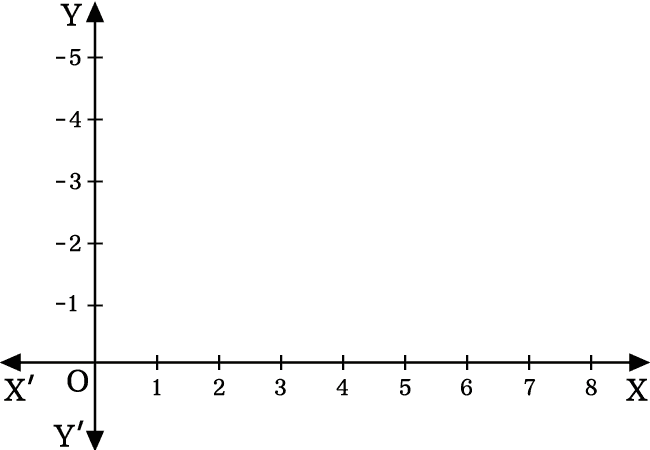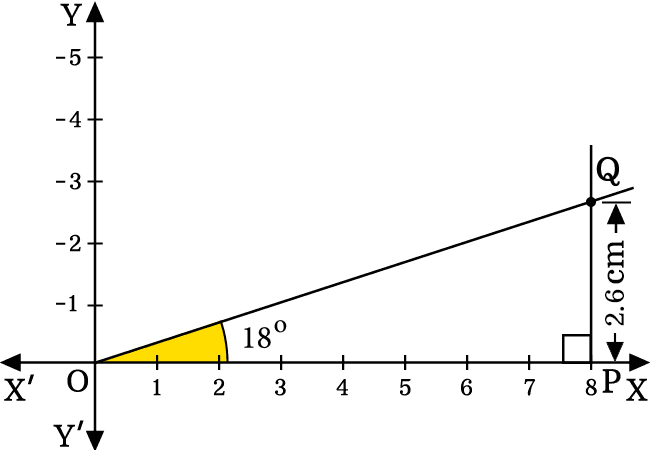The tan of eighteen degrees value in fraction and decimal forms are given here.
$\tan{(18^°)} \,=\, \dfrac{\sqrt{5}-1}{\sqrt{10+2\sqrt{5}}}$ $\,=\,$ $0.3249196962\ldots$
It can be derived mathematically in two different methods. Now, let’s learn the proof of tan of $18^°$ value in both methods for studying how the tan of eighteen degrees value is derived in mathematics.
In trigonometry, the value of tan of angle eighteen degrees can be derived exactly in fraction form. It is derived in mathematical form by considering some fundamental trigonometric identities.
The tan of angle eighteen degrees can be written in terms of sine and cosine of angle eighteen degrees as per the quotient rule of sine and cos functions.
$\tan{(18^°)}$ $\,=\,$ $\dfrac{\sin{(18^°)}}{\cos{(18^°)}}$
The cosine of angle eighteen degrees can be written in sine of angle eighteen degrees by the Pythagorean identity of sine and cosine functions.
$\implies$ $\tan{(18^°)}$ $\,=\,$ $\dfrac{\sin{(18^°)}}{\sqrt{1-\sin^2{(18^°)}}}$
The tangent of eighteen degrees is completely expressed in terms of sine of eighteen degrees. It clears that we must know the sine of eighteen degrees value for deriving the exact value of tan of eighteen degrees in trigonometry. So, substitute the sine of eighteen degrees value in the right hand side of the equation.
$\implies$ $\tan{(18^°)}$ $\,=\,$ $\dfrac{\dfrac{\sqrt{5}-1}{4}}{\sqrt{1-\Bigg(\dfrac{\sqrt{5}-1}{4}\Bigg)^2}}$
Now, simplify the mathematical expression at the right hand side of the equation for deriving the exact value for $\tan{(20^g)}$ in fraction form.
$\implies$ $\tan{(18^°)}$ $\,=\,$ $\dfrac{\dfrac{\sqrt{5}-1}{4}}{\sqrt{1-\dfrac{\Big(\sqrt{5}-1\Big)^2}{4^2}}}$
$\implies$ $\tan{(18^°)}$ $\,=\,$ $\dfrac{\dfrac{\sqrt{5}-1}{4}}{\sqrt{\dfrac{4^2-\Big(\sqrt{5}-1\Big)^2}{4^2}}}$
$\implies$ $\tan{(18^°)}$ $\,=\,$ $\dfrac{\dfrac{\sqrt{5}-1}{4}}{\dfrac{\sqrt{4^2-\Big(\sqrt{5}-1\Big)^2}}{\sqrt{4^2}}}$
$\implies$ $\tan{(18^°)}$ $\,=\,$ $\dfrac{\dfrac{\sqrt{5}-1}{4}}{\dfrac{\sqrt{4^2-\Big(\sqrt{5}-1\Big)^2}}{\sqrt{16}}}$
$\implies$ $\tan{(18^°)}$ $\,=\,$ $\dfrac{\dfrac{\sqrt{5}-1}{4}}{\dfrac{\sqrt{4^2-\Big(\sqrt{5}-1\Big)^2}}{4}}$
$\implies$ $\tan{(18^°)}$ $\,=\,$ $\dfrac{\sqrt{5}-1}{4} \times \dfrac{4}{\sqrt{4^2-\Big(\sqrt{5}-1\Big)^2}}$
$\implies$ $\tan{(18^°)}$ $\,=\,$ $\dfrac{\sqrt{5}-1}{\sqrt{4^2-\Big(\sqrt{5}-1\Big)^2}} \times \dfrac{4}{4}$
$\require{cancel} \implies$ $\tan{(18^°)}$ $\,=\,$ $\dfrac{\sqrt{5}-1}{\sqrt{4^2-\Big(\sqrt{5}-1\Big)^2}} \times \dfrac{\cancel{4}}{\cancel{4}}$
$\implies$ $\tan{(18^°)}$ $\,=\,$ $\dfrac{\sqrt{5}-1}{\sqrt{4^2-\Big(\sqrt{5}-1\Big)^2}} \times 1$
$\implies$ $\tan{(18^°)}$ $\,=\,$ $\dfrac{\sqrt{5}-1}{\sqrt{4^2-\Big(\sqrt{5}-1\Big)^2}}$
Now, the expression under the square root in the denominator can be simplified further by expanding the square of difference rule.
$\implies$ $\tan{(18^°)}$ $\,=\,$ $\dfrac{\sqrt{5}-1}{\sqrt{16-\Big((\sqrt{5})^2+1^2-2 \times (\sqrt{5}) \times 1\Big)}}$
$\implies$ $\tan{(18^°)}$ $\,=\,$ $\dfrac{\sqrt{5}-1}{\sqrt{16-\Big(5+1-2\sqrt{5}\Big)}}$
$\implies$ $\tan{(18^°)}$ $\,=\,$ $\dfrac{\sqrt{5}-1}{\sqrt{16-\Big(6-2\sqrt{5}\Big)}}$
$\implies$ $\tan{(18^°)}$ $\,=\,$ $\dfrac{\sqrt{5}-1}{\sqrt{16-6+2\sqrt{5}}}$
$\,\,\,\therefore \,\,\,\,\,\,$ $\tan{(18^°)}$ $\,=\,$ $\dfrac{\sqrt{5}-1}{\sqrt{10+2\sqrt{5}}}$
It is the exact value for the tan of eighteen degrees in fraction form. Thus, the $\tan{\Big(\dfrac{\pi}{10}\Big)}$ value is derived mathematically in trigonometric approach.
The value for the tan of angle eighteen degrees can also be derived geometrically by constructing a right triangle with eighteen degrees angle. However, it is not possible to derive the tan of $18$ degrees value exactly but it can be evaluated approximately.

Let’s construct a right triangle with eighteen degrees angle geometrically.
Thus, a right triangle that is denoted by $\Delta QOP$, is constructed geometrically with eighteen degrees angle.
In $\Delta QOP$, the angle is $18^°$. So, the tangent of eighteen degrees is written as $\tan{(18^°)}$ in mathematics. Now, express the $\tan{(18^°)}$ in terms of ratio of lengths of respective sides.

$\implies$ $\tan{(18^°)}$ $\,=\,$ $\dfrac{PQ}{OP}$
In this example, the length of the side $\overline{OP}$ is taken as $8\,cm$. Therefore, $OP \,=\, 8\,cm$ but the length of the side $\overline{PQ}$ is unknown. So, measure its length by a ruler. You will observe that its length is lies between $2.5$ to $2.6$ centimetres but very close to $2.6\,cm$. Therefore, the length of the side $\overline{PQ}$ is considered as $2.6\,cm$ approximately.
$\implies$ $\tan{(18^°)}$ $\,=\,$ $\dfrac{2.6}{8}$
$\,\,\,\therefore\,\,\,\,\,\,$ $\tan{(18^°)}$ $\,=\,$ $0.325$
We have successfully evaluated the tan of eighteen degrees value mathematically in two different methods.
In trigonometric approach, the $\tan{\Big(\dfrac{\pi}{10}\Big)}$ value is calculated in fraction form and it is proved that its value is an irrational number.
$\tan{(18^°)}$ $\,=\,$ $\dfrac{\sqrt{5}-1}{\sqrt{10+2\sqrt{5}}}$
$\implies$ $\tan{(18^°)}$ $\,=\,$ $0.3249196962\ldots$
In geometrical approach, the $\tan{(20^g)}$ value is calculated approximately in decimal form.
$\tan{(18^°)}$ $\,=\,$ $0.325$
According to trigonometry, the $\tan{(18^°)}$ is $0.3249196962\ldots$ but $\tan{(18^°)}$ is $0.325$ as per geometry. The two values of tan of eighteen degrees are different slightly. Now, let’s evaluate the difference between them for understanding the dispute between them.
$0.325$ $\,-\,$ $0.3249196962\ldots$ $\,=\,$ $0.0000803037\ldots$
$\implies$ $0.325$ $\,-\,$ $0.3249196962\ldots$ $\,\approx\,$ $0$
It can be understood that the two values are equal approximately even though the two values of tan of eighteen degrees are different slightly. However, we should not take $\tan{(18^°)}$ value that is obtained from geometric method as exact value because we have approximately taken the length of opposite side while calculating the tan function value in geometric method.
The exact value of $\tan{\Big(\dfrac{\pi}{10}\Big)}$ is derived in trigonometric approach from the fundamentals of trigonometry. Hence, the $\tan{(20^g)}$ value, which is obtained from trigonometric approach, is accurate.
A free math education service for students to learn every math concept easily, for teachers to teach mathematics understandably and for mathematicians to share their maths researching projects.
Copyright © 2012 - 2023 Math Doubts, All Rights Reserved